The Arc Product-Market Fit Framework
Arc 产品市场契合度框架
Finding product-market fit is the central quest of every early-stage startup. As we have seen over years of partnering with companies before they reached PMF, there are many ways of thinking about and approaching this quest. We walk founders through the following framework during Arc, our company-building immersion for pre-seed and seed stage companies.
寻找产品与市场的契合点是每个早期创业公司的核心任务。正如我们在与达到 PMF 之前的公司多年的合作中所看到的那样,有很多方法可以思考和实现这一目标。我们在 Arc 期间引导创始人完成以下框架,这是我们为种子期前和种子期公司提供的公司建设沉浸式体验。
Rather than diagnosing whether you have product-market fit, this framework outlines three distinct archetypes of PMF which help you understand your product’s place in the market and determine how your company operates.
该框架不是诊断您的产品是否适合市场,而是概述了 PMF 的三种不同原型,可帮助您了解产品在市场中的地位并确定公司的运营方式。
3 Archetypes of Product-Market Fit
3 产品与市场契合度的原型
Ultimately, product-market fit is about your product’s place in the world. There are different aspects to how your product fits into the world that you could hone in on—competitive landscape, the technical merits of your product, etc.
最终,产品与市场的契合度关系到您的产品在世界上的地位。您的产品如何融入这个世界,您可以从多个方面进行磨练——竞争格局、产品的技术优点等。
We think the best way is to start by focusing on how the customer relates to the problem your product solves.
我们认为最好的方法是首先关注客户与您的产品解决的问题的关系。
There are different kinds of problems, and different ways customers relate to them. We see three basic archetypes, each with its own distinct customer-product relationship dynamics.
问题有多种类型,客户处理这些问题的方式也不同。我们看到了三种基本原型,每种都有其独特的客户-产品关系动态。
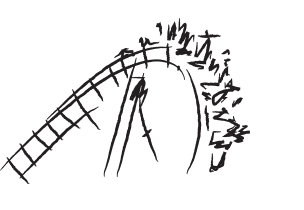
Hair on Fire
You solve a problem that’s a clear, urgent need for customers. The demand is obvious. Because of this, your category is likely crowded with competitors vying for market share.
您解决的问题是客户明确且迫切需要的。需求是显而易见的。因此,您的类别可能挤满了争夺市场份额的竞争对手。
Your customers are actively wrestling with the problem, and likely comparing existing products to solve it. To succeed in such a dynamic, you must rise above the noise. The only way to do so is by delivering the best-in-class solution.
您的客户正在积极解决该问题,并可能比较现有产品来解决该问题。为了在这样的动态中取得成功,你必须超越噪音。做到这一点的唯一方法是提供一流的解决方案。
And best-in-class products stand out because they are different, not merely better. You can’t just be faster or cheaper—you need a truly differentiated customer experience to have a durable advantage.
一流的产品之所以脱颖而出,是因为它们与众不同,而不仅仅是更好。您不能只是更快或更便宜,您需要真正差异化的客户体验才能拥有持久的优势。
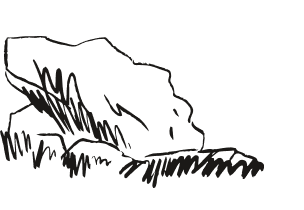
Hard Fact
You take a pain point universally accepted as a hard fact of life, and see that it’s merely a hard problem that your product solves for the customer. Your customers have resigned themselves to just living with the problem. They’re not urgently engaged with trying to solve it. The status quo is just how it is, and change doesn’t seem like an option.
你把一个普遍接受的痛点视为生活中的一个严峻事实,并发现这只是你的产品为客户解决的一个难题。您的客户已经接受了这个问题。他们并没有急于解决这个问题。现状就是这样,改变似乎不是一个选择。
You upend how things are done with an unexpected approach: Facts can’t be changed—but problems can be solved. The challenge to overcome is force of habit. Customers will have to change their current behaviors, and inertia is powerful.
你用意想不到的方法颠覆了做事的方式:事实无法改变,但问题可以解决。需要克服的挑战是习惯的力量。客户将不得不改变他们当前的行为,而惯性是强大的。
You need an approach that’s novel enough, for a problem that matters enough, to be worth making a change.
对于一个足够重要的问题,你需要一种足够新颖的方法,值得做出改变。
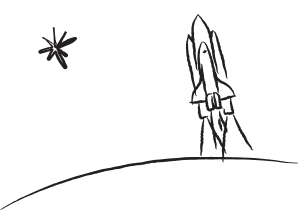
Future Vision
You enable a new reality through visionary innovation. It sounds like science fiction to customers, either because the concept is familiar but sounds impossible (like abundant cheap energy from nuclear fusion) or because no one ever imagined it (like the iPhone).
您可以通过富有远见的创新来实现新的现实。对于客户来说,这听起来像是科幻小说,要么是因为这个概念很熟悉,但听起来不可能(就像核聚变产生的丰富廉价能源),要么因为没有人想象过它(比如 iPhone)。
Customers are not only not trying to solve the problem, they are either oblivious to it or predisposed to think it’s a pipe dream. Either way, the obstacle is disbelief: Customers must believe that your product represents a whole new paradigm—often with its own ecosystem.
客户不仅没有试图解决问题,他们要么没有意识到这一点,要么倾向于认为这是一个白日梦。无论哪种方式,障碍都是难以置信:客户必须相信你的产品代表了一个全新的范式——通常有自己的生态系统。
(The iPhone wasn’t just a device; its App Store was a new way of interfacing with the internet. Tesla isn’t just a car; it’s a network of cameras and self-driving software that’s a new driving experience.) Customers must find the paradigm and its possibilities irresistible.
(iPhone 不仅仅是一个设备;它的 App Store 是一种与互联网连接的新方式。特斯拉不仅仅是一辆汽车;它是一个由摄像头和自动驾驶软件组成的网络,带来了一种新的驾驶体验。)客户必须发现这种范式及其可能性是不可抗拒的。
As we’ll discuss below, this path is often long, and finding the right route with the right commercial opportunities along the way is usually critical.
正如我们将在下面讨论的,这条道路通常很长,找到正确的路线以及沿途的正确商业机会通常至关重要。
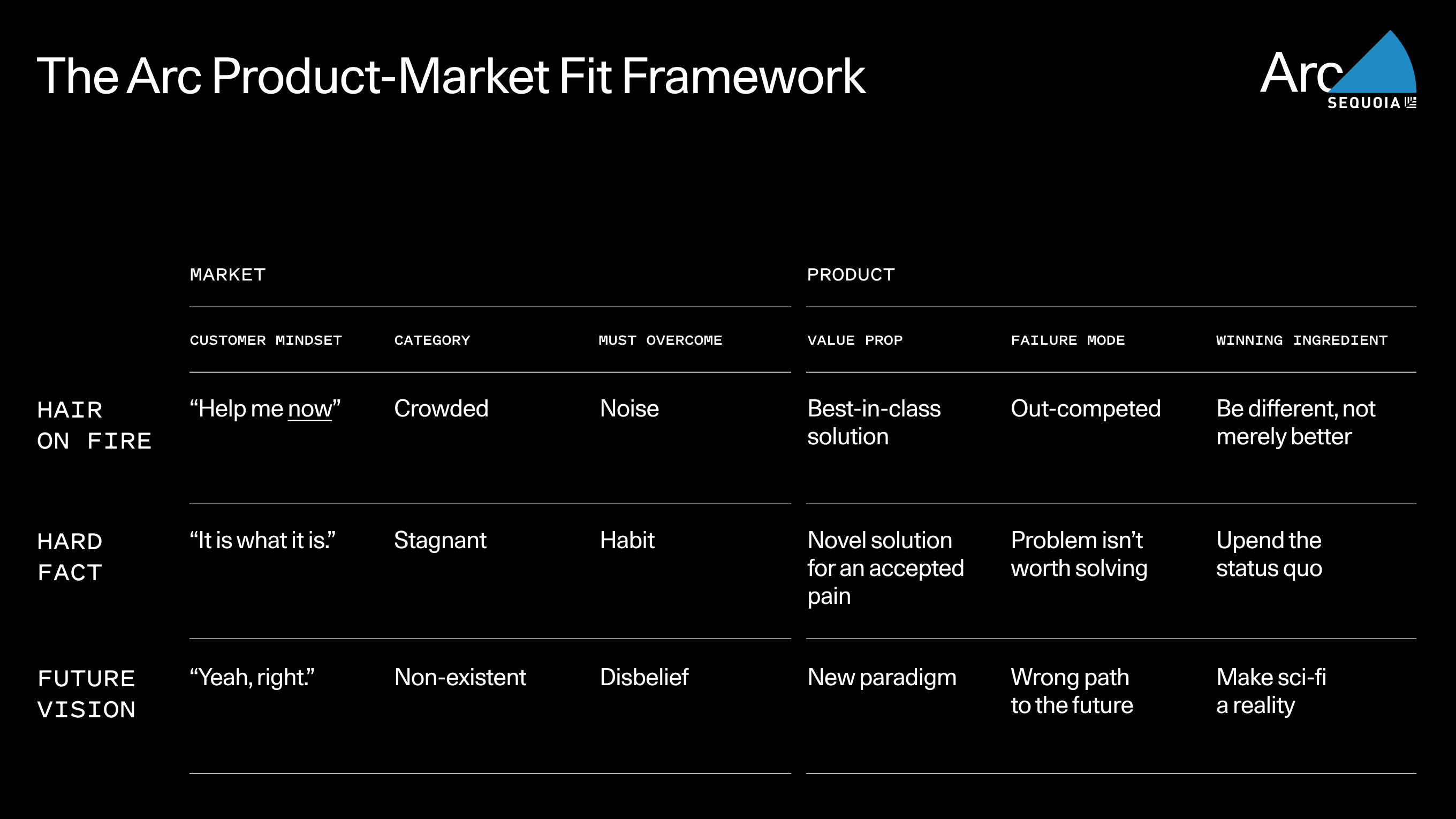
How to Operate in Each Path
各路径如何操作
Once you understand these archetypes, you can self-identify which path your company is on. Many founders we encounter in Arc assume they’re supposed to be in the Hair on Fire path. They have absorbed the adage to listen to what customers need. That’s good advice. But it often comes as a revelation that Hard Fact or Future Vision dynamics are viable options for finding PMF.
一旦您了解了这些原型,您就可以自行确定您的公司正在走哪条道路。我们在 Arc 中遇到的许多创始人都认为他们应该走在 Hair on Fire 之路上。他们吸收了“倾听客户需求”这句格言。这是个好建议。但事实往往表明,硬事实或未来愿景动态是寻找 PMF 的可行选择。
Hopefully you’re already working on a problem you have a unique advantage in solving. Your path, however, will be defined by how your customer relates to this problem (and how they feel about your solution). You can find success on any path—but each brings a distinct set of operating priorities that are essential to understand.
希望您已经在解决一个您在解决方面具有独特优势的问题。然而,您的路径将取决于您的客户如何处理这个问题(以及他们对您的解决方案的感受)。您可以在任何道路上找到成功,但每条道路都会带来一组独特的操作优先事项,这些都是必须理解的。
Path 1 – Hair on Fire
路径 1 – 头发着火
The Hair on Fire path requires both a great product and a great go-to-market effort—in quick succession. This combination of solution, selling and speed is the key to overcoming the competition.
“Hair on Fire”之路既需要出色的产品,又需要快速连续地投入巨大的市场营销努力。解决方案、销售和速度的结合是克服竞争的关键。
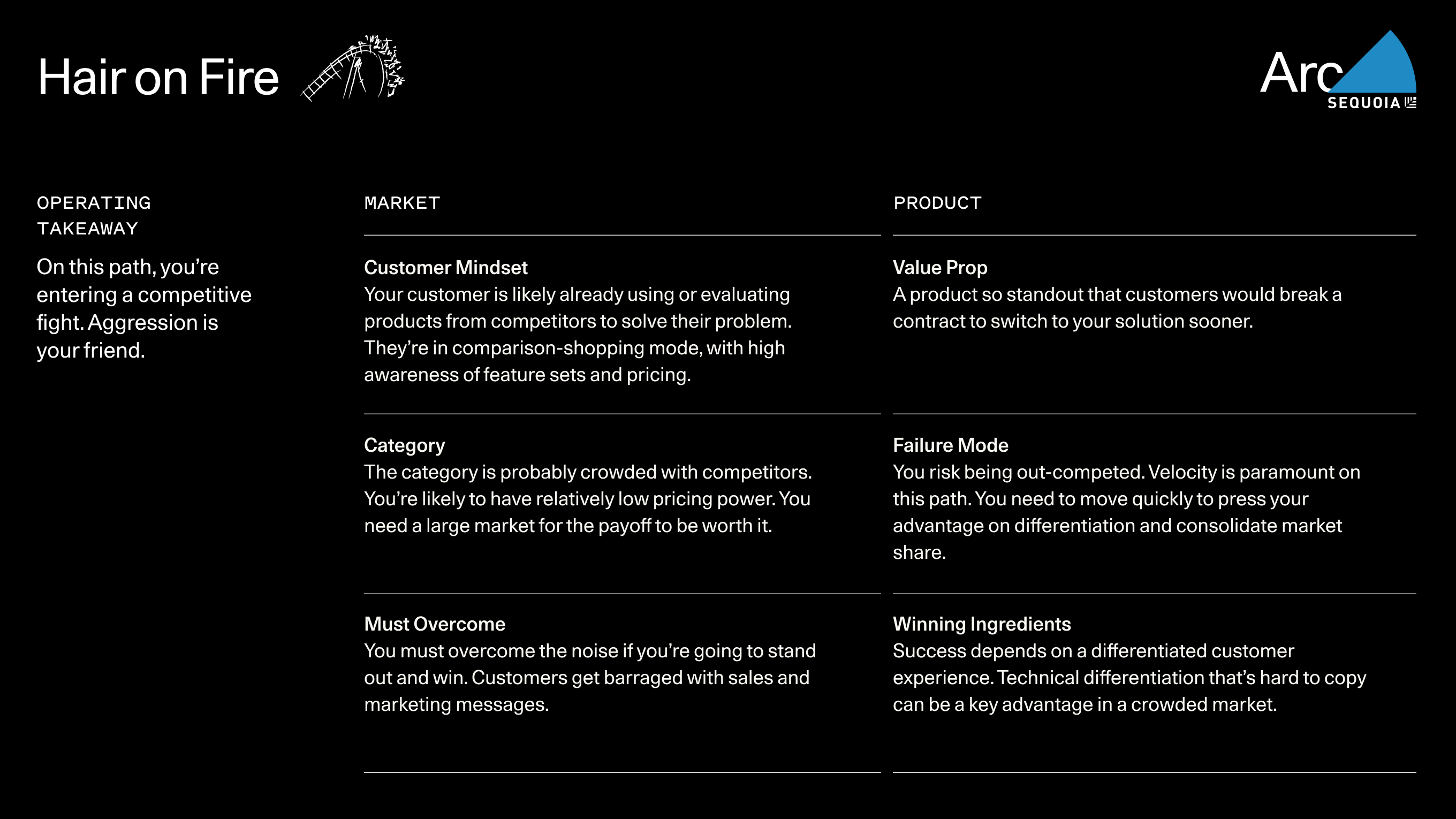
Hair on Fire – Case Studies
头发着火——案例研究
Along with product velocity, one hallmark of companies that break through to find success in the Hair on Fire path is the ability to aggressively out-maneuver the competition.
除了产品速度之外,在“头发着火”道路上取得突破并取得成功的公司的标志之一就是能够积极地战胜竞争对手。
Assaf Rappaport and his Wiz co-founders had previously founded Adallom together.
Assaf Rappaport 和他的 Wiz 联合创始人此前曾共同创立过 Adallom。
For their new company, they were intrigued by the problem of cloud infrastructure security—but it was already a crowded space with incumbents like Palo Alto Networks and startups like Orca Security offering products on the market.
对于他们的新公司来说,他们对云基础设施安全问题很感兴趣,但这个领域已经很拥挤,有 Palo Alto Networks 等老牌企业和 Orca Security 等初创公司在市场上提供产品。
However, when they interviewed CISOs, the topic kept surfacing at the top of everyone’s wish list. There was evident demand in a large market—but it took some digging to find the opportunity for differentiation.
然而,当他们采访 CISO 时,这个话题一直出现在每个人的愿望清单的首位。巨大的市场有明显的需求,但需要进行一些挖掘才能找到差异化的机会。
Most cloud security products relied on agents, a piece of software that needs to be installed in every server in order to monitor it. Wiz conceived an “agentless” solution that not only reduced friction and headaches, but surfaced vulnerabilities more effectively.
大多数云安全产品都依赖于代理,这是一种需要安装在每台服务器上才能对其进行监控的软件。 Wiz 构思了一种“无代理”解决方案,不仅减少了摩擦和麻烦,而且更有效地暴露了漏洞。
Even better, once connected it could surface those vulnerabilities in the course of a 15-minute customer demo.
更好的是,一旦连接,它可以在 15 分钟的客户演示过程中暴露这些漏洞。
Assaf and his team found their advantage, and floored the accelerator, aggressively out-maneuvering the competition: engineers built the product during their workday Israel time, and worked double-duty as sales reps at night—daytime in the U.S. They went from $0 to $2.8M in a single quarter and reached $100M in ARR in 18 months, setting a new record for the fastest-growing software company, ever.
阿萨夫和他的团队发现了自己的优势,并加大了加速器,积极地战胜了竞争对手:工程师在以色列的工作日制造产品,并在晚上(美国的白天)担任销售代表的双重职责。他们的收入从 0 美元涨到了 10 美元。单季度收入 280 万美元,18 个月内 ARR 达到 1 亿美元,创下了有史以来增长最快的软件公司的新纪录。
When Parker Conrad founded Rippling, he was entering a large Hair on Fire market. Every company needs HR software, and this urgency was reflected in the steep competition: there were already at least half a dozen incumbents fighting for market share.
当 Parker Conrad 创立 Rippling 时,他正在进入一个庞大的 Hair on Fire 市场。每家公司都需要人力资源软件,这种紧迫性反映在激烈的竞争中:已经有至少六家现有企业争夺市场份额。
In fact one of them was Parker’s own previous company Zenefits. Why bother? Because his deep expertise meant he knew what needed to be done differently: While other providers stitched together disparate datasets to offer a single platform for HR and benefits, Rippling’s approach was to build a unified database.
事实上,帕克之前的公司 Zenefits 就是其中之一。何必呢?因为他深厚的专业知识意味着他知道需要采取哪些不同的做法:当其他提供商将不同的数据集拼接在一起以提供单一的人力资源和福利平台时,Rippling 的方法是构建一个统一的数据库。
This foundation layer for employee data could then “ripple” out to any aspect of the employee experience, from benefits to expenses to device management.
然后,员工数据的基础层可以“波及”员工体验的任何方面,从福利到费用再到设备管理。
Their technical advantage created a different experience for HR, finance and IT administrators, which allowed Rippling to stand out and quickly grow market share in a field of incumbents.
他们的技术优势为人力资源、财务和 IT 管理员创造了不同的体验,这使得 Rippling 能够脱颖而出,并在现有企业领域迅速扩大市场份额。
And their strategy of bundling the widest set of employee experiences gave it pricing power even in a Hair on Fire dynamic where price leverage can be challenging for new entrants.
他们捆绑最广泛的员工体验的策略赋予了其定价能力,即使是在价格杠杆对新进入者来说可能具有挑战性的热火朝天的动态中。
Path 2 – Hard Fact
路径 2 – 确凿的事实
The Hard Fact path entails getting customers to re-evaluate and change the way they approach a current process. This requires first educating the market, and then capturing the opportunity.
硬事实路径需要让客户重新评估并改变他们处理当前流程的方式。这需要首先教育市场,然后抓住机会。
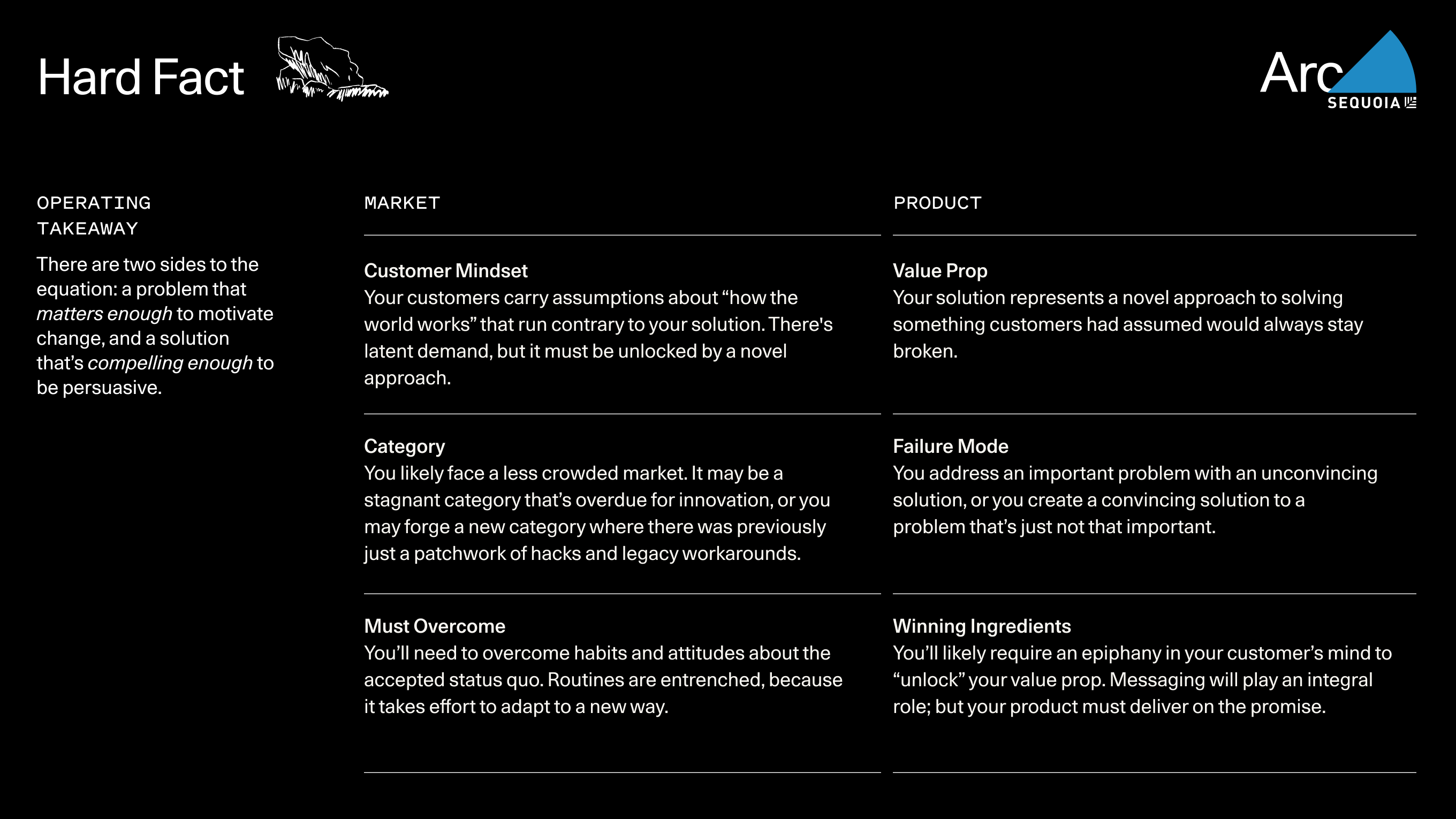
Hard Fact – Case Studies
铁的事实——案例研究
Your novel approach may replace an existing market (like Salesforce moving CRM to the cloud) or it may create a new market (like Uber reimagining the taxi experience as a rideshare marketplace).
您的新颖方法可能会取代现有市场(例如 Salesforce 将 CRM 迁移到云端),也可能会创建一个新市场(例如 Uber 将出租车体验重新构想为共享出行市场)。
Either way, you will likely face less competition on the Hard Fact path because the difficulty of changing the status quo has discouraged other founders from taking on the problem.
不管怎样,你在“硬事实”道路上面临的竞争可能会减少,因为改变现状的困难阻碍了其他创始人解决这个问题。
To succeed, Uber had to not only convince legions of everyday people to drive strangers around, but also engage with taxi unions, local regulations and labor laws. Others’ natural aversion to such difficulty means you’ll likely get more of a greenfield opportunity.
为了取得成功,Uber 不仅必须说服大量普通人载陌生人出行,还必须遵守出租车工会、当地法规和劳动法的规定。其他人对这种困难的自然厌恶意味着你可能会获得更多的新机会。
When Block (then Square) first launched, the hard fact they were addressing was widely known and acknowledged: “cash only.” For many small businesses or at any farmers’ market, there was no way to accept credit cards.
当 Block(当时的 Square)首次推出时,他们所要解决的一个事实是广为人知和承认的:“只收现金”。对于许多小企业或任何农贸市场来说,都无法接受信用卡。
Consumers would trudge off to find ATMs and merchants would often miss out on sales. Jack Dorsey and Jim McKelvey’s unique insight was that smartphones, which were just becoming ubiquitous, could be effectively turned into mobile credit card terminals.
消费者会费力寻找自动取款机,而商家往往会错过促销机会。杰克·多尔西和吉姆·麦凯尔维的独特见解是,刚刚普及的智能手机可以有效地转变为移动信用卡终端。
Square realized that this supposed hard fact of life was actually a hard problem that it could solve. But finding success meant getting the world to see it no longer had to live with this pain point, and to trust Square’s solution enough to adopt their new way.
Square 意识到,这个看似困难的生活事实实际上是一个它可以解决的难题。但取得成功意味着让世界看到它不再需要忍受这个痛点,并充分信任 Square 的解决方案以采用他们的新方式。
In order to activate this epiphany and win over early adopters who would evangelize the product, Square made an early decision to give its hardware and software away for free to merchants and figure out a business model later. Eventually, Square became a new standard.
为了激活这种顿悟并赢得早期采用者的青睐并宣传该产品,Square 很早就决定将其硬件和软件免费提供给商家,然后再制定商业模式。最终,Square 成为了新标准。
In 2006, marketing mainly consisted of advertising, mailers and telemarketing. This put small businesses at a disadvantage, as these were all high-cost channels.
2006年,营销主要包括广告、邮寄和电话营销。这使小企业处于不利地位,因为这些都是高成本渠道。
Brian Halligan and Dharmesh Shah realized there was a new way: small companies could leverage the properties of the fast-maturing internet—blogs, social media, SEO, email newsletters—to reach audiences at a fraction of the cost of traditional channels.
Brian Halligan 和 Dharmesh Shah 意识到有一种新方法:小公司可以利用快速成熟的互联网的特性——博客、社交媒体、搜索引擎优化、电子邮件通讯——以传统渠道成本的一小部分来接触受众。
HubSpot’s suite of content, SEO and email management tools solved this problem for customers. But in order for customers to believe in their approach and begin adopting their product, HubSpot needed to crystalize the new way in customers’ minds—to make them aware that the old way was broken and could be replaced with something better. They did this by coining a term for their new way—“inbound marketing”— and even wrote a book about it.
HubSpot 的内容、SEO 和电子邮件管理工具套件为客户解决了这个问题。但为了让客户相信他们的方法并开始采用他们的产品,HubSpot 需要在客户的脑海中具体化新的方式,让他们意识到旧的方式已经被打破,可以用更好的方式取代。为此,他们为自己的新方式创造了一个术语——“入站营销”——甚至还写了一本关于它的书。
They were so effective at educating the market that the idea caught on and started a marketing revolution in the small business world, propelling HubSpot to product-market fit and beyond.
他们在教育市场方面非常有效,以至于这个想法在小企业界流行起来并引发了一场营销革命,推动 HubSpot 走向产品市场契合甚至超越。
Path 3 – Future Vision
路径 3 – 未来愿景
The Future Vision path has the most ways to fail and the fewest to succeed, but potentially the largest payoff. Taking this path requires endurance and the ability to attract and retain top talent for the long haul.
未来愿景之路失败的方式最多,成功的方式最少,但潜在的回报却最大。走这条路需要耐力以及长期吸引和留住顶尖人才的能力。
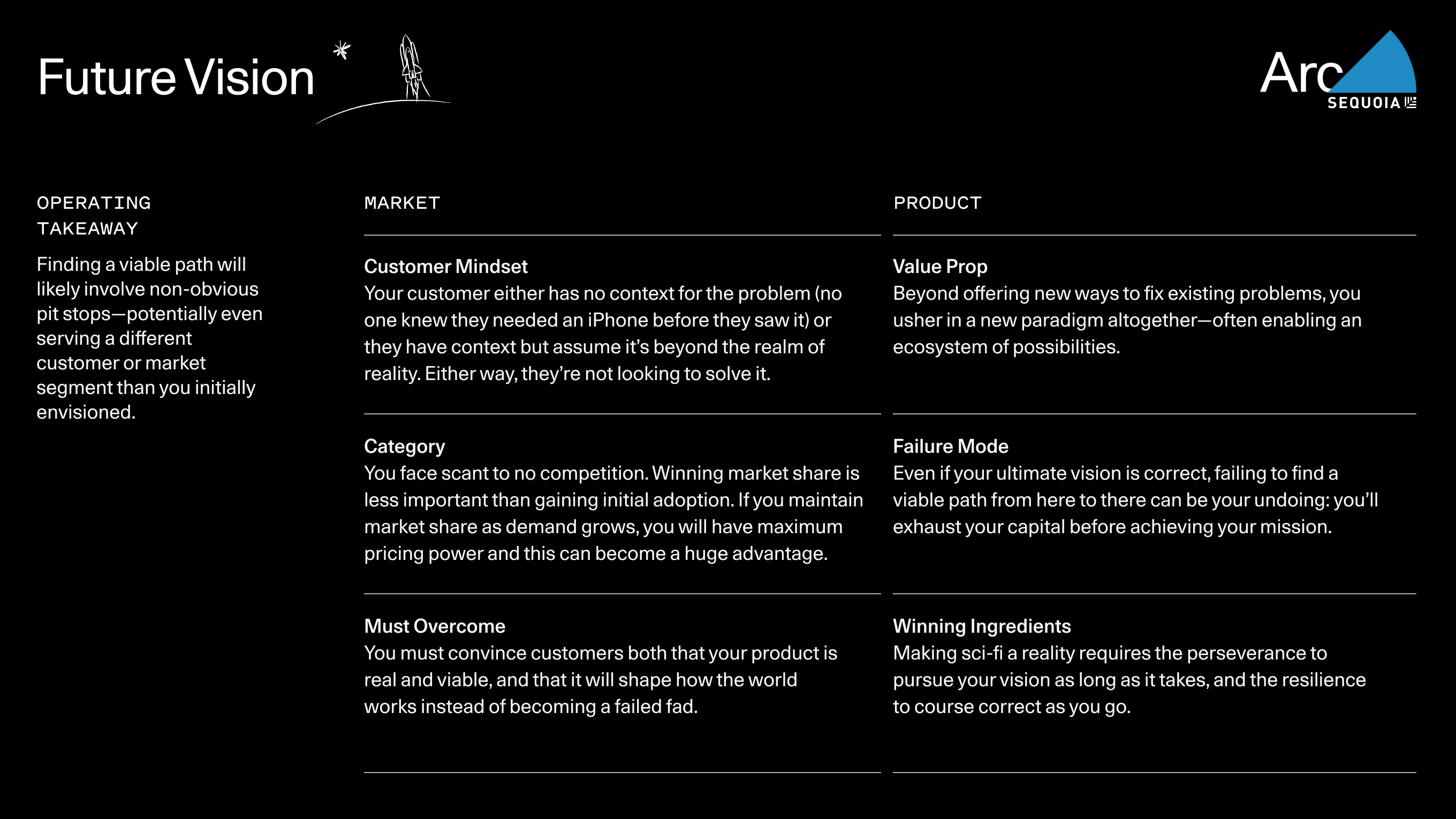
Future Vision – Case Studies
Philosopher Søren Kierkegaard said, “Life can only be understood by looking backward, but it must be lived looking forward.” Future Vision founders like Nvidia’s Jensen Huang, who took a tortuous 30-year path to reach the company’s founding ambition, can probably relate.
Nvidia’s initial vision was to uplevel what PCs are capable of with a 3D graphics chip that would transform the experience of using a computer. When Nvidia released its first chip, it was so ahead of its time that no one knew what to do with it.
It took six years and three product lines to find product-market fit in an industry where the GPU enabled irresistible new possibilities: video games.
While Nvidia’s original ambition wasn’t limited to the video game industry, it became synonymous with gaming innovation, with its GPUs powering both PCs and Xboxes.
Were it not for that very productive pit stop—which propelled Nvidia to profitability and IPO—the company never would have survived long enough to power today’s AI revolution. In fact, they were teetering on bankruptcy before finding PMF in gaming.
Thirty years from its founding, Nvidia is enabling a new computing paradigm as GPUs transform everything from data centers to cloud computing.
Future Vision products that fail to find PMF are often described as being “too early.” For instance, 11 years after Google Glass launched, augmented reality still hasn’t gone mainstream. This is precisely why finding pit stops with commercial traction along the way is so critical. Assuming your vision is correct and you can find a viable path, time is on your side with the Future Vision archetype: You can amass an insurmountable headstart while the world comes around to your paradigm. But finding the right pit stops can be difficult.
You must act with imperfect information—“live looking forward,” as Kierkegaard said—and the pitfalls are always more obvious in hindsight. Oftentimes finding the right path means embracing unexpected turns, both with the technology you produce and the market you serve.
OpenAI is one of the most interesting Future Vision stories of our time. Its vision is to achieve artificial general intelligence (AGI)—long considered a pipe dream in technology circles—and to do so for the benefit of humanity.
To achieve this, they started as a non-profit, since the founders thought the profit motive of a company would undermine their mission of human benefit.
A few years into the journey, however, they realized that the cost of compute needed to innovate their large language models outstripped the fundraising capacity of even the best-connected non-profit. Their path required a turn into the for-profit sector.
Adopting a more traditional startup structure brought funding as well as expectations for product launches—hence ChatGPT. It instantly found product-market fit in the iPhone paradigm of “I couldn’t imagine wanting it until I saw it.” Consumer demand for generative AI was nascent in 2022. In 2023, OpenAI generated $1.6B. While ChatGPT achieved the fastest adoption of any consumer technology product ever, for OpenAI it’s the pit stop they need on the way toward their real ambition.
Putting it All Together
Using the framework of these three paths—and keeping in mind that one isn’t better than the others—you can reflect on your own product’s place in the world. What path are you on? How do customers relate to the problem you’re solving?
Are you thinking about the right category dynamics? What are your operating priorities? Do you need to optimize for velocity and scale, land an epiphany with early adopters, or strategize the pit stops in your journey?
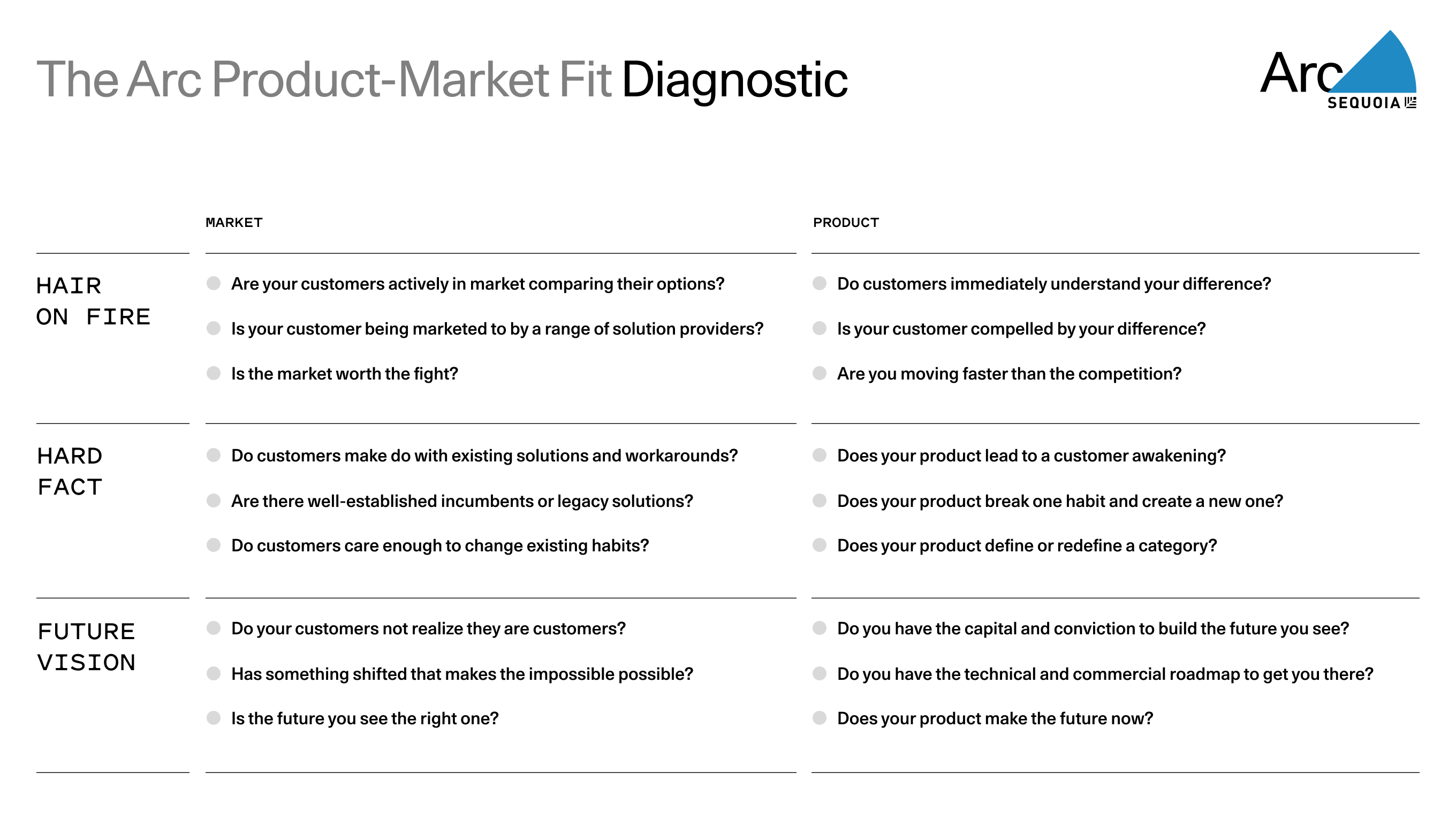
The Quest Continues
Practice is always messier than theory, and as you apply this thinking in the real world there are several important nuances to keep in mind:
Product-market relationship dynamics are fluid. Over time, many companies end up moving from one path to another as they introduce new products or as customer attitudes change about an existing product and underlying problem. Some companies straddle two paths at once.
The point of this framework is not to irrevocably set your path in stone; it would be a mistake to identify yourself too narrowly with any one of them.
Apple, for instance, started as a Future Vision. The company’s initial memo to Sequoia in 1978 acknowledged that there was zero demand for household computers.
“Apple management,” it stated, “believes that most potential customers of 1980 do not today have the slightest interest in purchasing a home computer.” As they captured imaginations and grew in popularity in the ’80s, however, the category of personal computers was no longer a Future Vision.
By 1998, with the launch of iMac, Apple addressed a Hard Fact: computers, while increasingly ubiquitous, were impersonal. The iPhone instantly found PMF as a Future Vision when Steve Jobs unveiled it in 2007. The smartphone category then quickly shifted to Hair on Fire dynamics and a flood of new smartphones entered the market.
Apple managed to retain its dominance by defining the category, being right and continuing to innovate. Today, Apple is introducing yet another Future Vision with Apple Vision Pro.
The device leverages the 10X advancements in sensors developed for the iPhone: the fruits of one product’s PMF journey can create seeds for the next.
Will Apple Vision Pro enable entirely new experiences we can’t yet imagine, and fall squarely in the Hair on Fire path a few years from now? Time will tell.
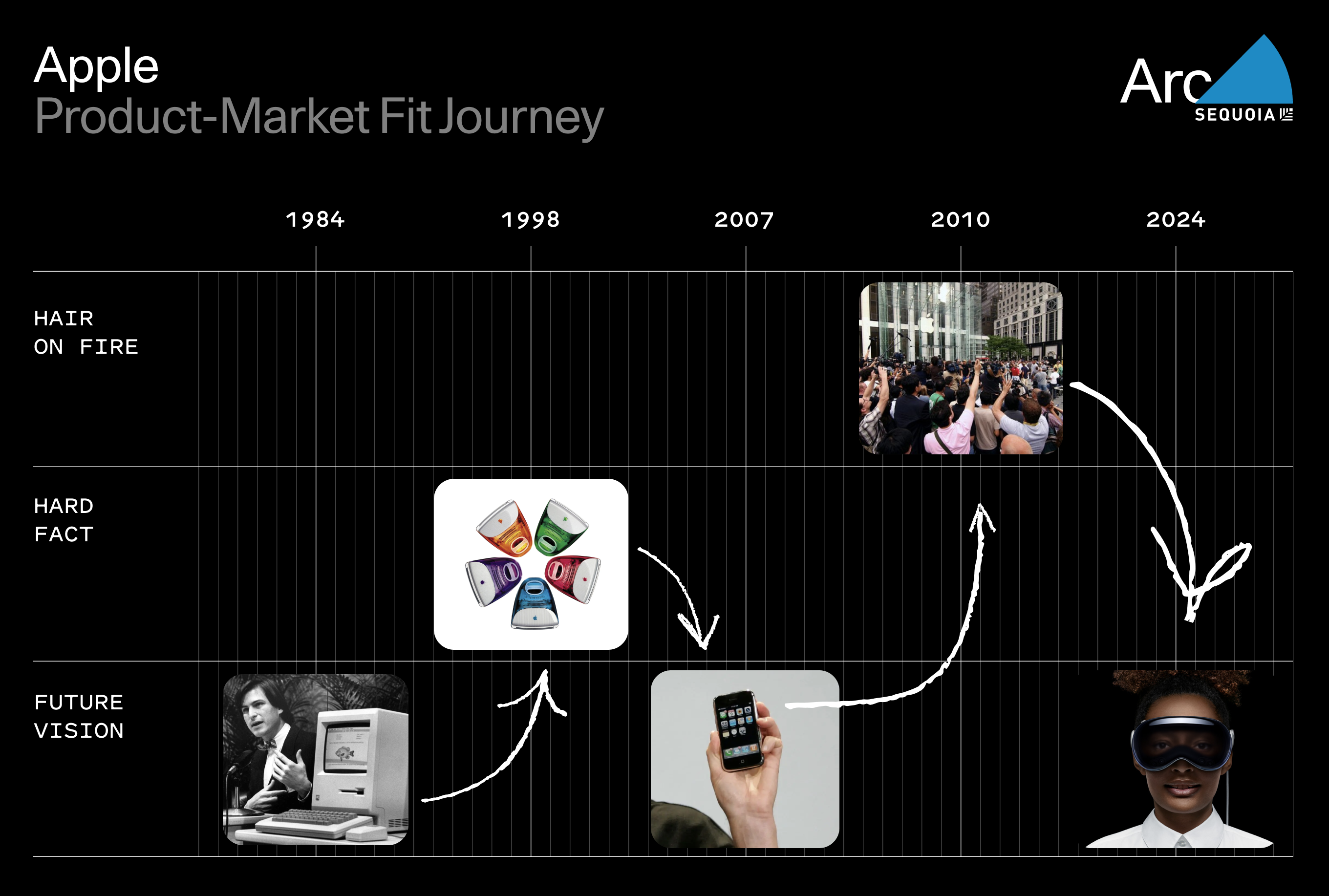
Legendary companies string together multiple product lines that evolve through one path of product-market fit to another. While one product may plateau, the next product starts rising.
You can use this framework to orient yourself regardless of where you are in this cycle. PMF may seem like a destination you’re trying to reach—but keeping and expanding on it once you arrive is an ongoing quest that will last as long as your company does.